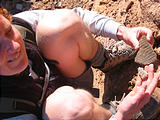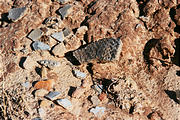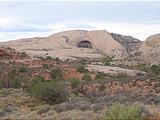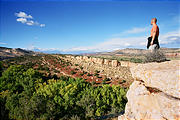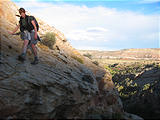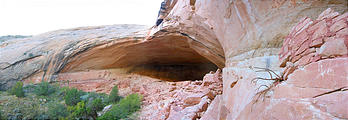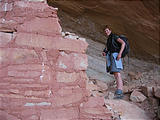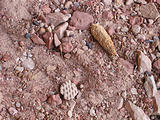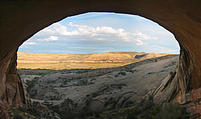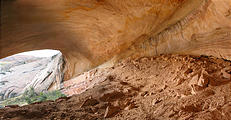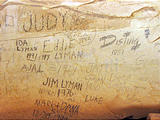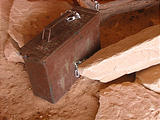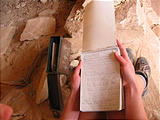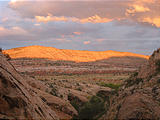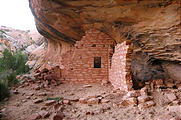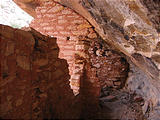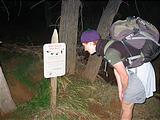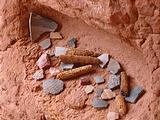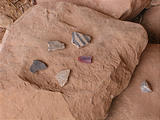Comb Ridge - Caves & Ruins
Day 1
After our resupply in Moab, we headed out of town the next morning, south towards the Comb Ridge area (northwest of Bluff, UT). Geoff had explored this area before on his last trip in 2001 . Laura was interested in seeing it after hearing all his stories. We left the pavement of Highway 95, heading south into Butler Wash on road 262.
Upon entering this area, a signed warned us that there were significant historical remains in the area and that we should not disturb them. Looking at our USGS topographical map of the road, we spotted over a dozen locations marked "ruins". Later we came to realize that there were significantly more ruins than just those marked on our map — those were just the beginning. Comb Ridge is an incredibly rich place to explore if you enjoy finding native American ruins.
So we immediately set out to find cave that Geoff had investigated a few years before. We first looked for the ancient potsherds that Geoff had said littered the river bank. Laura wasn't quite so convinced these were actual pottery pieces — couldn't they just be thin rocks? After some more looking around, we found several had crosshatch patterns on them — as if they had been formed with mud pressed into a basket of reeds. For some reason, this sent shivers down Laura's spine — realizing that these were remains of people living 800-900 years ago, just sitting by the side of the river, broken into pieces.
We could see up the valley to a significant cave (Fish Mouth Cave). Geoff had a fairly vivid memory of what the ruins in the cave looked like, but not the cave itself. We navigated over the rocks (keeping off of the cryptobiotic soil!) and made our way up to this cave.
We found our way up to the cave, but where were the ruins? Geoff's heart sank. There were a couple walls in one corner, but the floor of the cave was all piles of sand and rock. Had the buildings and artifacts Geoff remembered been destroyed or removed? The floor looked like it was the end result of a big digging project. The back wall of the cave, we saw, was lined with graffiti (including some from the early 1900's) written in black with charcoal. Either something dramatic had happened in the past four years, or perhaps this was not the cave Geoff had seen his previous trip.
So we started back the way we came, hoping we had the wrong cave. We spotted another cave, which was empty except for an ammunition box hidden behind some rocks. Inside the box was information about the local caves and ruins, with a log book! In the log book, people were raving about what they had seen. We were hopeful to see more.
The next cave on the way back had a significant number of low walls but still was not the one that Geoff remembered. We backtracked some more, and finally found a cave just how Geoff remembered it!
It was now getting close to dark but we quickly looked around. Amazing to see the walls and how well preserved everything was, considering the time. Comparing our photos from this trip to ones Geoff took five years earlier , you can see that very little had noticeably changed. One rock that was somewhat precariously balanced on a wall then was still in the same position. It makes us happy to think that a place like this can be left unprotected and vulnerable, and yet be generally respected by visitors. There were piles of pottery shards (like we had seen in the riverbed), arrowheads, and corn cobs left in place for others to see. Corn cobs from how many hundreds of years ago? It's amazing that they are still there. Here's a great web site on exploring this area.
It was dark when we made it back to our van to camp for the night.
Day 2
That night we picked out some more Comb Ridge ruins on our topo map, and the next day we set out to find them. Getting to this new location required more of a hike. We studied the topographic map to figure out how we were going to get there. Unfortunately, we forgot to bring our printer on this trip, so we drew by hand a little sketch of roughly what the topography looked like.
We first got distracted by a wrong valley, which had many caves to check out but they were all exposed to water and plant growth, and empty of ruins.
We then climbed over to the next valley, and briefly spotted a stunning fuzzy-tailed fox darting away. Finally we found what we were looking for: a good sized cave with quite a few remaining walls and artifacts. And we had and excellent view out over the western side of Comb Ridge. Proud of our accomplishment, we felt like little Indiana Jones', back from an archeological adventure!
As we later drove south through the rest of the Comb Ridge, we couldn't believe the just how many more distant ruins we could spot from the road. We could have spent weeks in Comb Ridge, taking side trips up into the valleys, learning how each site differed. But instead we pressed on, leaving the area late in the day. Our goal was to camp in the Valley of the Gods.




